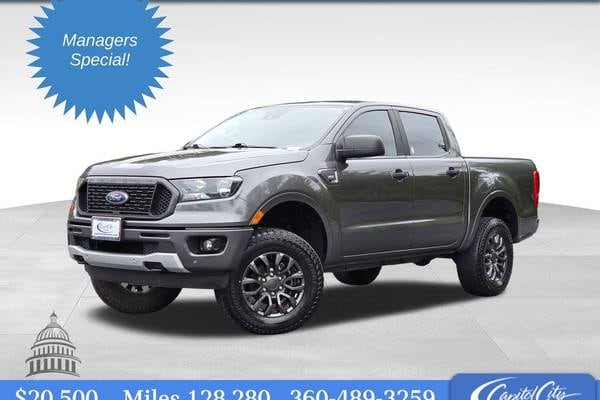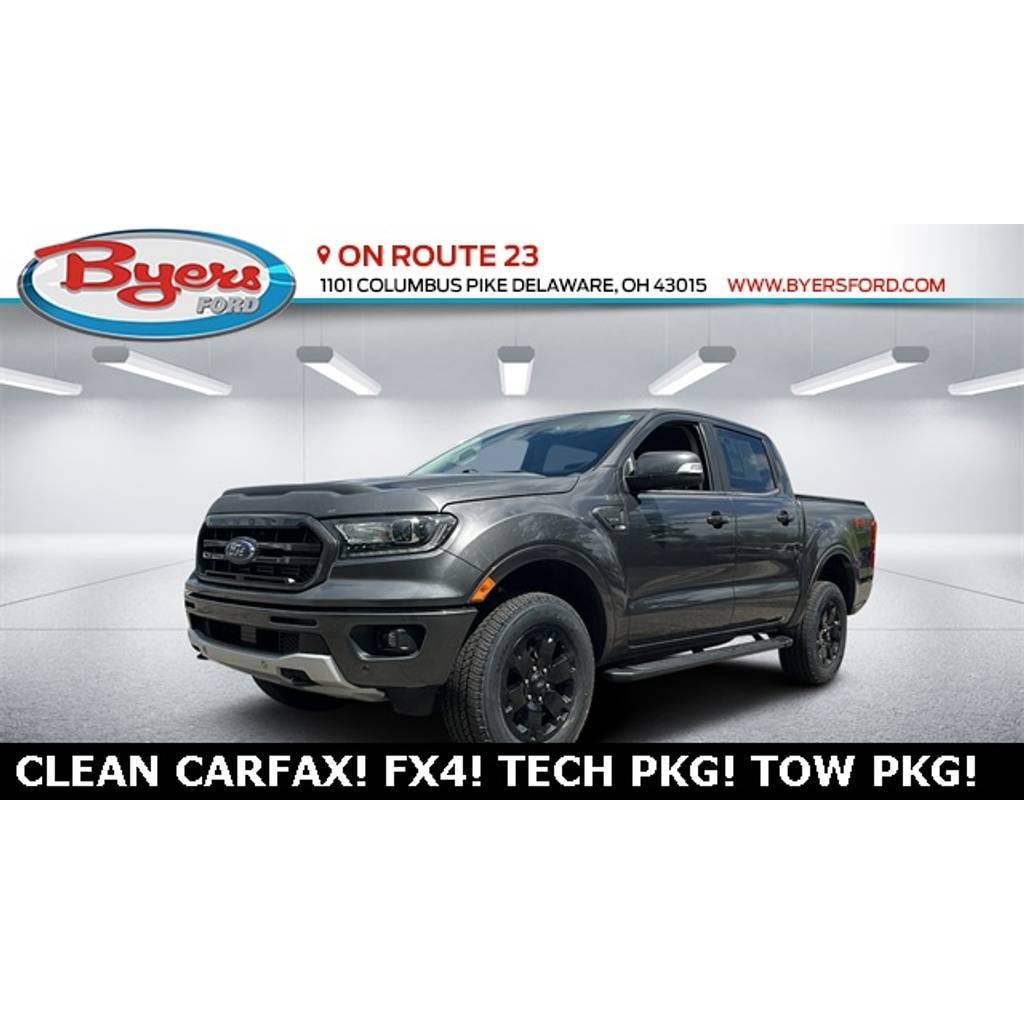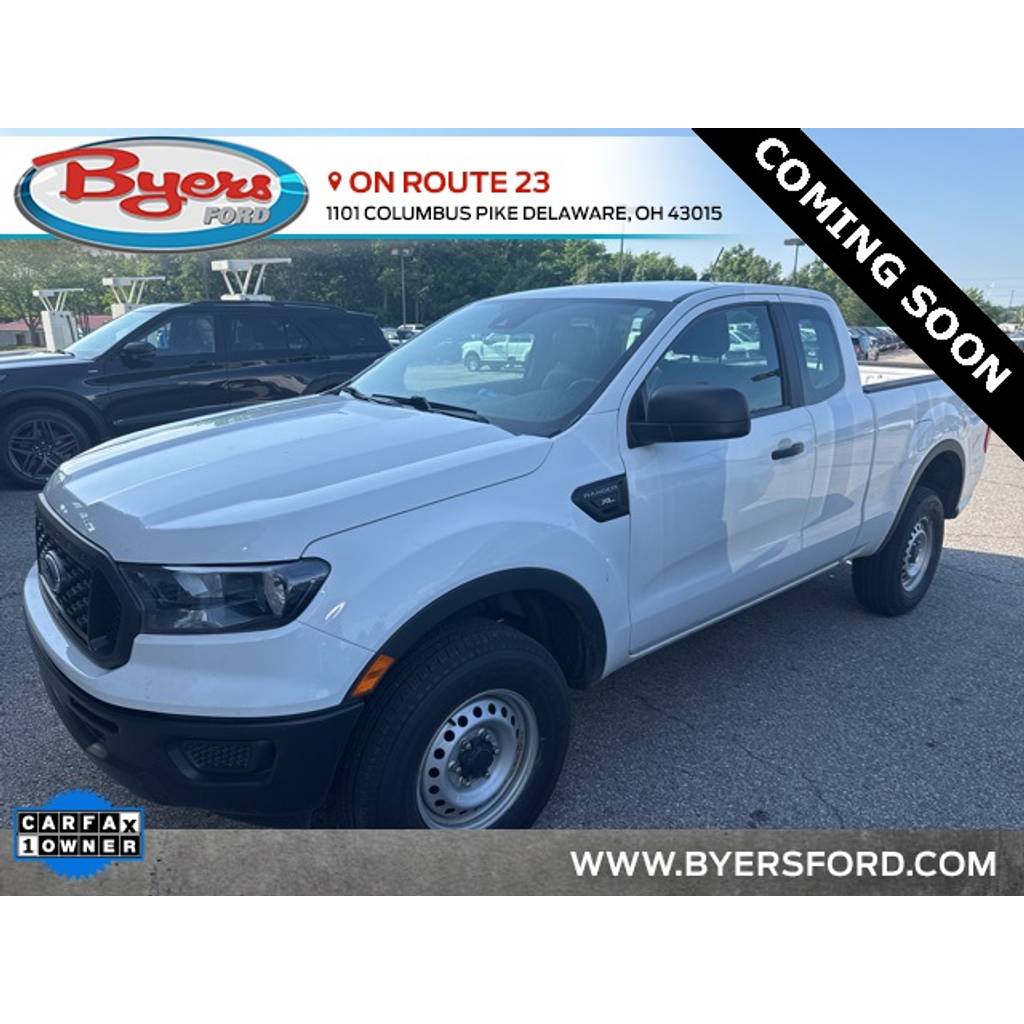- $26,999good price$1,625 below market
- 86,068 miles
- No accidents, 2 owners, personal use only
- 5'1” bed, 2.3l, 4cyl
- Auto Max USA (38 mi away)
Close
Located in Puyallup, WA / 38 miles away from Bothell, WA
Auto Max USA in Puyallup, carrying the best Chevrolet, Ford, GMC, RAM, and Toyota Trucks in the Sound area! If you are looking for a Silverado, Sierra...
AutoCheck Vehicle History Summary
Accident Free Vehicle: Yes
Personal Use Only: Yes
History Provider: AutoCheck
Title Details: Clean Title
Salvage Vehicle: No
Frame Damage: No
Theft History: No
Lemon Status: No
Free History Report: No
Features and Specs:
22 Combined MPG (20 City/24 Highway)
Listing Information:
VIN: 1FTER4FHXKLA05787
Stock: 22565
Certified Pre-Owned: No
Listed since: 04-21-2025 - $21,500good price$1,288 below market
- 128,280 miles
- No accidents, 2 owners, personal use only
- 5'1” bed, 2.3l, 4cyl
- Capitol City Honda (60 mi away)
- Home delivery*
Close
Located in Olympia, WA / 60 miles away from Bothell, WA
AutoCheck Vehicle History Summary
Accident Free Vehicle: Yes
Personal Use Only: Yes
History Provider: AutoCheck
Title Details: Clean Title
Salvage Vehicle: No
Frame Damage: No
Theft History: No
Lemon Status: No
Free History Report: No
Features and Specs:
22 Combined MPG (20 City/24 Highway)
Listing Information:
VIN: 1FTER4FH9KLB23099
Stock: N2739A
Certified Pre-Owned: No
Listed since: 05-28-2025 - $23,950good price$1,544 below market
- 121,670 miles
- No accidents, 2 owners, personal use only
- 5'1” bed, 2.3l, 4cyl
- Sunset Cars Select (30 mi away)
Close
Located in Auburn, WA / 30 miles away from Bothell, WA
AutoCheck Vehicle History Summary
Accident Free Vehicle: Yes
Personal Use Only: Yes
History Provider: AutoCheck
Title Details: Clean Title
Salvage Vehicle: No
Frame Damage: No
Theft History: No
Lemon Status: No
Free History Report: No
Features and Specs:
22 Combined MPG (20 City/24 Highway)
Listing Information:
VIN: 1FTER4FH9KLA41065
Stock: 7390
Certified Pre-Owned: No - $29,998good price$1,704 below market
- 55,640 miles
- No accidents, 2 owners, personal use
- 5'1” bed, 2.3l, 4cyl
- CarMax Puyallup (38 mi away)
Close
Located in Puyallup, WA / 38 miles away from Bothell, WA
CarMax values transparency and wants you to love your next car, not settle on it. Certain vehicles may have unrepaired safety recalls. Check nhtsa.gov...
AutoCheck Vehicle History Summary
Accident Free Vehicle: Yes
Personal Use Only: Yes
History Provider: AutoCheck
Title Details: Clean Title
Salvage Vehicle: No
Frame Damage: No
Theft History: No
Lemon Status: No
Free History Report: No
Features and Specs:
22 Combined MPG (20 City/24 Highway)
Listing Information:
VIN: 1FTER4FH0KLA76786
Stock: 27454162
Certified Pre-Owned: No - $35,888
- 10,629 miles
- No accidents, 1 owner, personal use only
- 5'1” bed, 2.3l, 4cyl
- GT Auto Sales (39 mi away)
Close
Located in Tacoma, WA / 39 miles away from Bothell, WA
AutoCheck Vehicle History Summary
Accident Free Vehicle: Yes
Personal Use Only: Yes
History Provider: AutoCheck
Title Details: Clean Title
Salvage Vehicle: No
Frame Damage: No
Theft History: No
Lemon Status: No
Free History Report: No
Features and Specs:
22 Combined MPG (20 City/24 Highway)
Listing Information:
VIN: 1FTER4FH5KLB17154
Stock: 7717
Certified Pre-Owned: No
Listed since: 05-09-2025 - 71,397 miles
- No accidents, 1 owner, personal use only
- 5'1” bed, 2.3l, 4cyl
- Dick's Canby Ford (174 mi away)
Close
Located in Canby, OR / 174 miles away from Bothell, WA
AutoCheck Vehicle History Summary
Accident Free Vehicle: Yes
Personal Use Only: Yes
History Provider: AutoCheck
Title Details: Clean Title
Salvage Vehicle: No
Frame Damage: No
Theft History: No
Lemon Status: No
Free History Report: No
Features and Specs:
22 Combined MPG (20 City/24 Highway)
Listing Information:
VIN: 1FTER4FH8KLA13726
Stock: KLA13726
Certified Pre-Owned: No
Listed since: 04-18-2025- Not Priced
- 51,236 miles
- No accidents, 2 owners, personal use only
- 5'1” bed, 2.3l, 4cyl
- Sunset Chevrolet (38 mi away)
Close
Located in Sumner, WA / 38 miles away from Bothell, WA
Fresh Trade! 2019 Ford Ranger Lariat w/ only 51k Miles and Many extra's Including Sunset's Exclusive "Warranty Protection for Life", the peace of mind...
AutoCheck Vehicle History Summary
Accident Free Vehicle: Yes
Personal Use Only: Yes
History Provider: AutoCheck
Title Details: Clean Title
Salvage Vehicle: No
Frame Damage: No
Theft History: No
Lemon Status: No
Free History Report: No
Features and Specs:
22 Combined MPG (20 City/24 Highway)
Listing Information:
VIN: 1FTER4FHXKLA50292
Stock: D24520AA
Certified Pre-Owned: No
Listed since: 04-14-2025 - 58,499 miles
- No accidents, 2 owners, rental vehicle
- 5'1” bed, 2.3l, 4cyl
- Four Ten Auto Sales (41 mi away)
Close
Located in Bonney Lake, WA / 41 miles away from Bothell, WA
MORE PHOTOS COMING AFTER DETAIL!! CALL FOR MORE INFO- 253-750-3268
AutoCheck Vehicle History Summary
Accident Free Vehicle: Yes
Personal Use Only: No
History Provider: AutoCheck
Title Details: Clean Title
Salvage Vehicle: No
Frame Damage: No
Theft History: No
Lemon Status: No
Free History Report: No
Features and Specs:
22 Combined MPG (20 City/24 Highway)
Listing Information:
VIN: 1FTER4FH0KLA06009
Stock: 2508
Certified Pre-Owned: No
Listed since: 06-20-2025- Not Priced
- 64,756 miles
- No accidents, 1 owner, personal use only
- 5'1” bed, 2.3l, 4cyl
- Sound Ford (20 mi away)
Close
Located in Renton, WA / 20 miles away from Bothell, WA
AutoCheck Vehicle History Summary
Accident Free Vehicle: Yes
Personal Use Only: Yes
History Provider: AutoCheck
Title Details: Clean Title
Salvage Vehicle: No
Frame Damage: No
Theft History: No
Lemon Status: No
Free History Report: No
Features and Specs:
22 Combined MPG (20 City/24 Highway)
Listing Information:
VIN: 1FTER4FH6KLB22900
Stock: 255560A
Certified Pre-Owned: No
Listed since: 06-29-2025 - 44,500 miles
- 1 accident, 3 owners, corporate fleet vehicle
- 5'1” bed, 2.3l, 4cyl
- West Hills Ford (25 mi away)
Close
Located in Bremerton, WA / 25 miles away from Bothell, WA
AutoCheck Vehicle History Summary
Accident Free Vehicle: No
Personal Use Only: No
History Provider: AutoCheck
Title Details: Clean Title
Salvage Vehicle: No
Frame Damage: No
Theft History: No
Lemon Status: No
Free History Report: No
Features and Specs:
22 Combined MPG (20 City/24 Highway)
Listing Information:
VIN: 1FTER4FH4KLA23556
Stock: XF7457
Certified Pre-Owned: Yes
Listed since: 06-30-2025- $31,800great price$3,926 below market
- 34,680 miles
- No accidents, 2 owners, personal use only
- 5'1” bed, 2.3l, 4cyl
- Sports Cars International - Lynnwood South (6 mi away)
Close
Located in Lynnwood, WA / 6 miles away from Bothell, WA
Unleash your adventurous spirit with the 2020 Ford Ranger, a pickup truck that combines rugged capability with modern sophistication. Designed for tho...
AutoCheck Vehicle History Summary
Accident Free Vehicle: Yes
Personal Use Only: Yes
History Provider: AutoCheck
Title Details: Clean Title
Salvage Vehicle: No
Frame Damage: No
Theft History: No
Lemon Status: No
Free History Report: No
Features and Specs:
22 Combined MPG (20 City/24 Highway)
Listing Information:
VIN: 1FTER4FH8LLA42631
Stock: 21489
Certified Pre-Owned: No
Listed since: 04-14-2025 - $30,950
- 57,000 miles
- No accidents, 2 owners, personal use only
- 5'1” bed, 2.3l, 4cyl
- Northwest Premier Auto Sales (179 mi away)
Close
Located in Kennewick, WA / 179 miles away from Bothell, WA
AutoCheck Vehicle History Summary
Accident Free Vehicle: Yes
Personal Use Only: Yes
History Provider: AutoCheck
Title Details: Clean Title
Salvage Vehicle: No
Frame Damage: No
Theft History: No
Lemon Status: No
Free History Report: No
Features and Specs:
22 Combined MPG (20 City/24 Highway)
Listing Information:
VIN: 1FTER4FH2KLB24207
Stock: B24207
Certified Pre-Owned: No Close
Located in Renton, WA / 20 miles away from Bothell, WA
AutoCheck Vehicle History Summary Unavailable.
Features and Specs:
22 Combined MPG (20 City/24 Highway)
Listing Information:
VIN: 1FTER4FH3KLA01662
Stock: 259100A
Certified Pre-Owned: No
Listed since: 07-01-2025- $35,896good price$2,357 below market
- 15,171 miles
- No accidents, 1 owner, personal use only
- 5'1” bed, 2.3l, 4cyl
- Lexus of Portland (158 mi away)
Close
Located in Portland, OR / 158 miles away from Bothell, WA
ONLY 15,168 Miles! Heated Leather Seats, Back-Up Camera, 4x4, Turbo, Bed Liner, Tow Hitch, CHROME APPEARANCE PACKAGE, TOUGH BED SPRAY-IN BEDLINER, TRA...
AutoCheck Vehicle History Summary
Accident Free Vehicle: Yes
Personal Use Only: Yes
History Provider: AutoCheck
Title Details: Clean Title
Salvage Vehicle: No
Frame Damage: No
Theft History: No
Lemon Status: No
Free History Report: No
Features and Specs:
22 Combined MPG (20 City/24 Highway)
Listing Information:
VIN: 1FTER4FH4LLA48135
Stock: LLA48135
Certified Pre-Owned: No
Listed since: 06-28-2025 - $31,998fair price$816 below market
- 63,290 miles
- No accidents, 3 owners, personal use only
- 5'1” bed, 2.3l, 4cyl
- Haselwood Chevrolet GMC (25 mi away)
Close
Located in Bremerton, WA / 25 miles away from Bothell, WA
4WD.Haselwood Chevrolet GMC is honored to offer this tremendous, reliable 2020 Ford Ranger Lariat.Certified.Priced below KBB Fair Purchase Price...
AutoCheck Vehicle History Summary
Accident Free Vehicle: Yes
Personal Use Only: Yes
History Provider: AutoCheck
Title Details: Clean Title
Salvage Vehicle: No
Frame Damage: No
Theft History: No
Lemon Status: No
Free History Report: No
Features and Specs:
22 Combined MPG (20 City/24 Highway)
Listing Information:
VIN: 1FTER4FH3LLA50491
Stock: XG5677A
Certified Pre-Owned: No
Listed since: 06-16-2025 - $34,000fair price$51 below market
- 22,159 miles
- No accidents, 2 owners, personal use only
- 5'1” bed, 2.3l, 4cyl
- Capitol City Honda (60 mi away)
- Home delivery*
Close
Located in Olympia, WA / 60 miles away from Bothell, WA
Recent Arrival! Priced below KBB Fair Purchase Price! CARFAX One-Owner. Clean CARFAX.This 2020 Shadow Black Ford Ranger XLT 4WD is well equipped and...
AutoCheck Vehicle History Summary
Accident Free Vehicle: Yes
Personal Use Only: Yes
History Provider: AutoCheck
Title Details: Clean Title
Salvage Vehicle: No
Frame Damage: No
Theft History: No
Lemon Status: No
Free History Report: No
Features and Specs:
22 Combined MPG (20 City/24 Highway)
Listing Information:
VIN: 1FTER4FH8LLA39468
Stock: N2588A
Certified Pre-Owned: No
Listed since: 06-28-2025 - $29,910fair price$922 above market
- 53,797 miles
- No accidents, 1 owner, corporate fleet vehicle
- 5'1” bed, 2.3l, 4cyl
- Duffy's Auto Brokerage (29 mi away)
Close
Located in Auburn, WA / 29 miles away from Bothell, WA
*RECENT ARRIVAL* *2020 FORD RANGER XLT SUPERCREW* *MAGNETIC* *4X4* *AUTO* *2.4L ECOBOOST* *SPORT APPEARANCE PACKAGE* *BACKUP CAMERA* *BLUETOOTH* *TOW ...
AutoCheck Vehicle History Summary
Accident Free Vehicle: Yes
Personal Use Only: No
History Provider: AutoCheck
Title Details: Clean Title
Salvage Vehicle: No
Frame Damage: No
Theft History: No
Lemon Status: No
Free History Report: No
Features and Specs:
22 Combined MPG (20 City/24 Highway)
Listing Information:
VIN: 1FTER4FH2LLA83868
Stock: 13024
Certified Pre-Owned: No
Listed since: 06-04-2025 - $35,989fair price$388 above market
- 49,112 miles
- No accidents, personal use only
- 5'1” bed, 2.3l, 4cyl
- Sunset Auto Wholesale (40 mi away)
Close
Located in Tacoma, WA / 40 miles away from Bothell, WA
AutoCheck Vehicle History Summary
Accident Free Vehicle: Yes
Personal Use Only: Yes
History Provider: AutoCheck
Title Details: Clean Title
Salvage Vehicle: No
Frame Damage: No
Theft History: No
Lemon Status: No
Free History Report: No
Features and Specs:
22 Combined MPG (20 City/24 Highway)
Listing Information:
VIN: 1FTER4FH7LLA48310
Stock: 9491
Certified Pre-Owned: No
Listed since: 04-07-2025 - $24,990fair price$703 below market
- 95,576 miles
- 1 accident, 2 owners, personal use only
- 5'1” bed, 2.3l, 4cyl
- Driveway (157 mi away)
- Home delivery*
Close
Located in Portland, OR / 157 miles away from Bothell, WA
Apple CarPlay,Back-Up Camera,Blind Spot Monitor,Bluetooth,Brake Assist,Lane Keeping Assist,Navigation System,Remote Start,Satellite Radio,Tow Hitch,Tu...
AutoCheck Vehicle History Summary
Accident Free Vehicle: No
Personal Use Only: Yes
History Provider: AutoCheck
Title Details: Clean Title
Salvage Vehicle: No
Frame Damage: No
Theft History: No
Lemon Status: No
Free History Report: No
Features and Specs:
22 Combined MPG (20 City/24 Highway)
Listing Information:
VIN: 1FTER4FH6LLA37704
Stock: LLA37704T
Certified Pre-Owned: No - $31,608fair price$426 above market
- 27,537 miles
- No accidents, 1 owner, personal use only
- 5'1” bed, 2.3l, 4cyl
- Harris Ford Lincoln (7 mi away)
Close
Located in Lynnwood, WA / 7 miles away from Bothell, WA
4WD. Clean CARFAX.2020 Ford Ranger XLT 4WD Red Metallic 10-Speed Automatic EcoBoost 2.3L I4 GTDi DOHC Turbocharged VCT, 2020 Model Year, Rapid Red ...
AutoCheck Vehicle History Summary
Accident Free Vehicle: Yes
Personal Use Only: Yes
History Provider: AutoCheck
Title Details: Clean Title
Salvage Vehicle: No
Frame Damage: No
Theft History: No
Lemon Status: No
Free History Report: No
Features and Specs:
22 Combined MPG (20 City/24 Highway)
Listing Information:
VIN: 1FTER4FH6LLA51702
Stock: H250643A
Certified Pre-Owned: No
Listed since: 06-22-2025 - Not Priced
- 72,714 miles
- No accidents, personal use only
- 5'1” bed, 2.3l, 4cyl
- Sunset Ford (39 mi away)
Close
Located in Sumner, WA / 39 miles away from Bothell, WA
New Arrival! "1 Owner" 2020 Ford Ranger Lariat w/ 72k Miles and Many Extra's Including Sunset's Exclusive "Warranty Protection for Life", the peace of...
AutoCheck Vehicle History Summary
Accident Free Vehicle: Yes
Personal Use Only: Yes
History Provider: AutoCheck
Title Details: Clean Title
Salvage Vehicle: No
Frame Damage: No
Theft History: No
Lemon Status: No
Free History Report: No
Features and Specs:
22 Combined MPG (20 City/24 Highway)
Listing Information:
VIN: 1FTER4FH0LLA18386
Stock: 9688
Certified Pre-Owned: No
Listed since: 06-17-2025
Consumer Reviews for the Ford Ranger
Ranger vs. Colorado and Gladiator
Applied Filters5Active
Make & Model
Year
New / Used
Price & Payments
Price Rating
Trim
Truck Details
Mileage
Accidents & History
Engine & Drivetrain
Exterior Color
Interior Color
Total Seating
Edmunds Review
Features
Options & Packages
MPG
* Delivery of any kind does not apply to Alaska and Hawaii. Contact the dealer for delivery details, restrictions and costs.






















